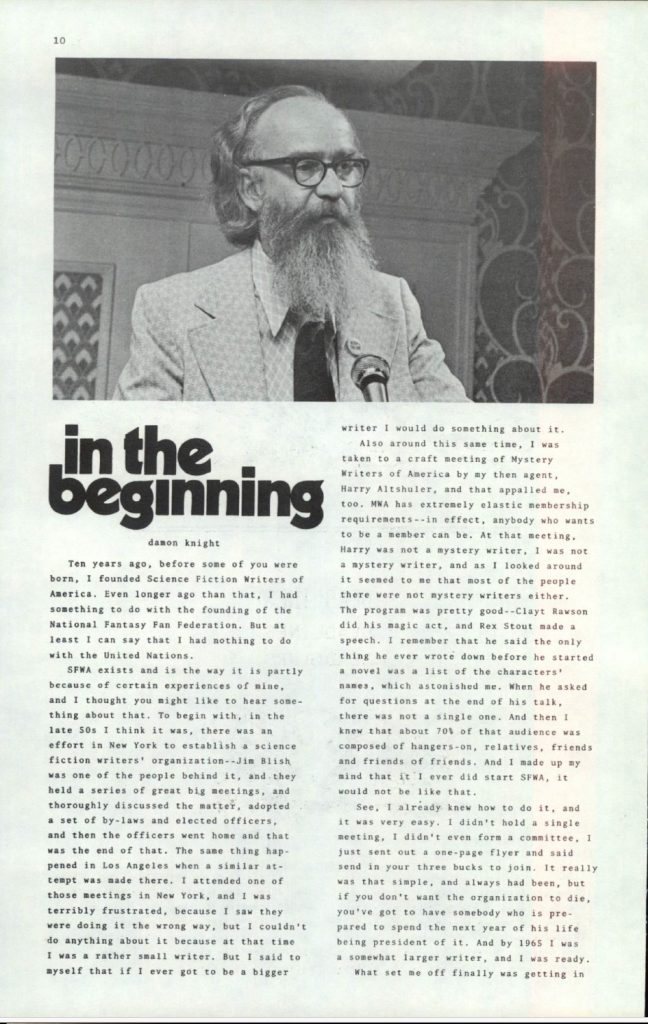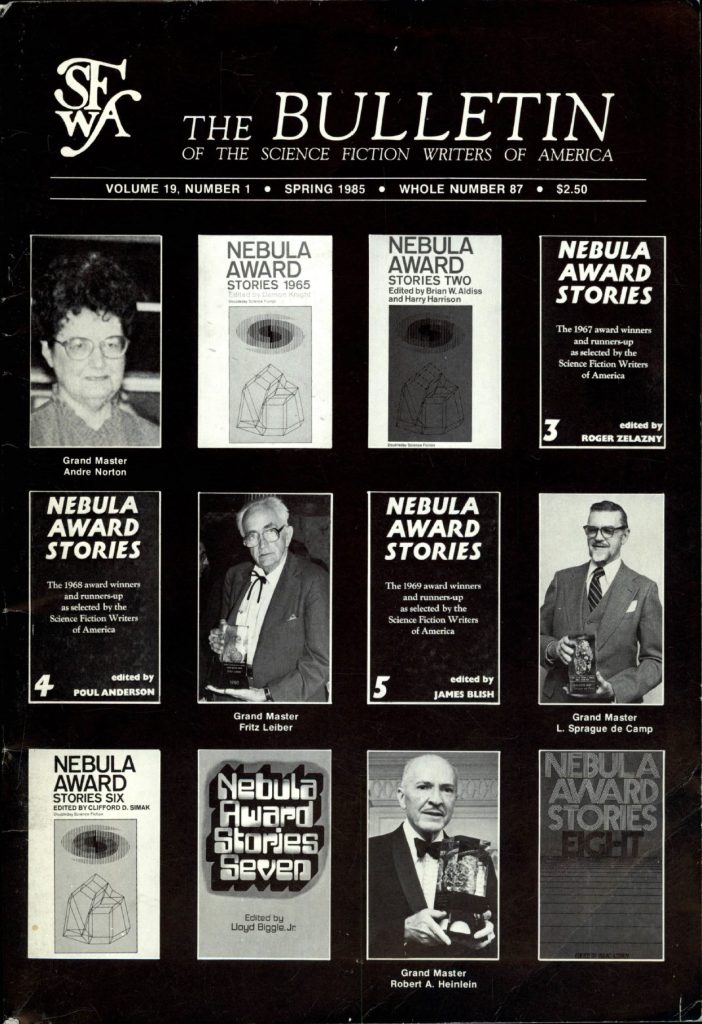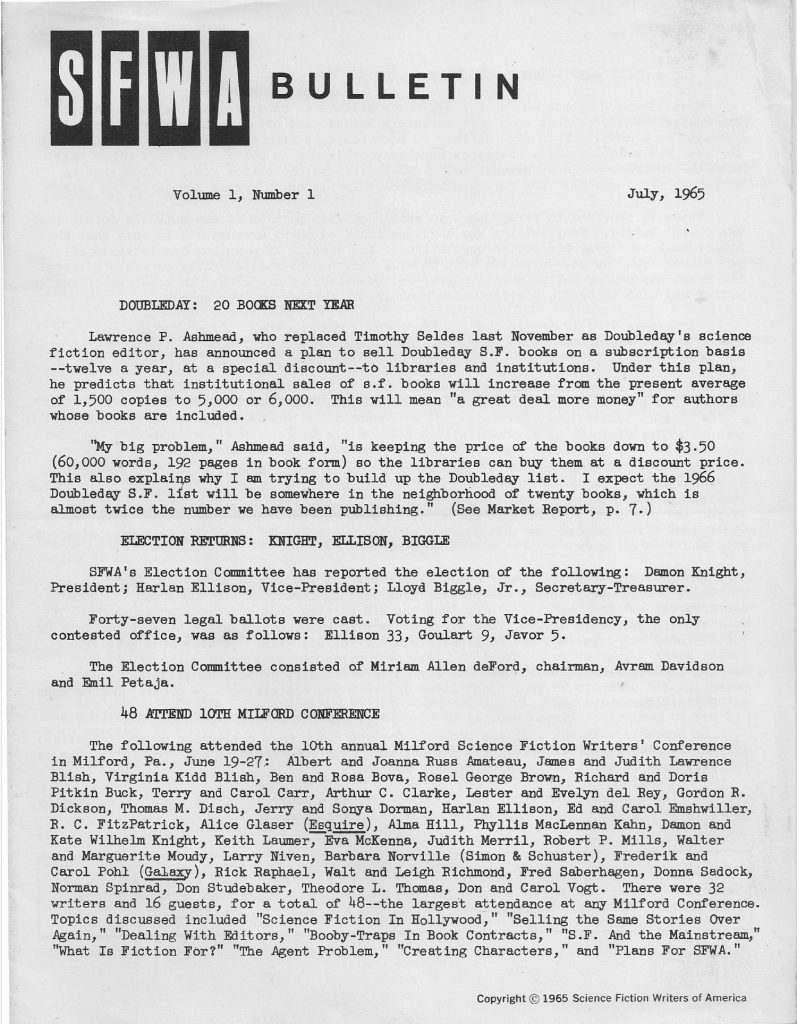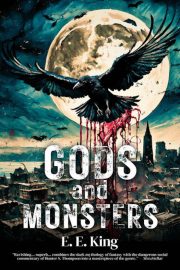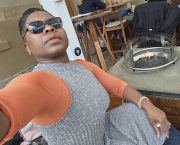A Brief History of SFWA: The Beginning (Part 1)
by Michael Capobianco
Editor’s note: This piece is the first in a two-part overview of the first year of SFWA, curated by a member of the organization’s History Committee. Part 2 is available here.
On January 15, 1965, Damon Knight, a well-known author, critic, and co-founder of the Milford Conference writer’s workshop, sent an announcement by US Mail to every professional science fiction writer he could locate, asking for $3 from anyone who wanted more of the same. Science Fiction Writers of America (SFWA) was born.
It was not the first attempt to create an organization of American professional science fiction authors, and there were genre writer precursors. In the 1930s, The American Fiction Guild was formed to help pulp writers with their business concerns; it’s mainly remembered now because L. Ron Hubbard was president of its NY chapter. Mystery Writers of America, arguably a model for some aspects of SFWA, had been established in 1945. MWA’s membership policy was not one of those aspects, however.
Figure 1. In the beginning. Scanned copy of a page from the 10th anniversary issue of the SFWA Bulletin, from the collection of Michael Capobianco. July, 1975.
Writing in the 10th-anniversary issue of the SFWA Bulletin, SFWA’s primary publication through most of its existence, Knight talks about attending a meeting of the MWA and realizing that most of the attendees were not writers: “I knew that about 70 percent of that audience was composed of hangers-on, relatives, friends, and friends of friends. And I made up my mind that if I ever did start SFWA, it would not be like that.” (Figure 1.)
There had been a few abortive attempts to create an organization specifically for professional science fiction writers before SFWA. Knight recalled, “To begin with, in the late 50s, I think it was, there was an effort in New York to establish a science fiction writers’ organization—Jim Blish was one of the people behind it, and they held a series of great big meetings and thoroughly discussed the matter, adopted a set of by-laws and elected officers, and then the officers went home, and that was the end of that. The same thing happened in Los Angeles when a similar attempt was made there. I attended one of those meetings in New York, and I was terribly frustrated because I saw they were doing it the wrong way, but I couldn’t do anything about it because, at that time, I was a rather small writer. But I said to myself that if I ever got to be a bigger writer, I would do something about it.”
In the third issue of the Bulletin, James Blish has a slightly different account: “…Fred Pohl, Lester del Rey, and I tried to get a ‘professional’s Hugo’ going; it died primarily because Fred suddenly became editor-in-fact of Galaxy and no longer felt it proper to be associated with such a project, and Les—who was quite ill at the time—and I couldn’t carry it alone.” The first attempt on the West Coast was named the Science Fantasy Writers of America and did have a number of meetings through the early fifties but ultimately evaporated. In the mid-sixties, A. E. van Vogt tried to create a “SFWPA,” but it was abandoned when SFWA began to take off.
Figure 2. SFWA’s The Bulletin, Volume 19, Number 1. Scanned copy of the cover page, from the collection of Michael Capobianco. Spring, 1985.
In the Spring 1985 SFWA Bulletin celebrating SFWA’s 20th Anniversary (Figure 2), Knight remembered the moment of SFWA’s creation: “It was like (I think) the moment when you know you are going down a ski slope for the first time. I had wanted to do it for years, had known how to do it, but the time was not ripe. One day, I got in the mail two requests for permission to reprint stories in return for flat fees. I wrote a broadside denouncing flat fees and mailed it to all the science fiction writers I knew. At the bottom of the page, I said, more or less, ‘If you would like to receive more information like this, send your $3.’”
According to Knight, “[t]he checks rolled in. When I had seventy-eight subscribers, I arbitrarily declared them the charter members of SFWA, drew up a set of by-laws, and held an election.” Knight sent out the list of charter members along with the proposed by-laws and a pamphlet About Anthologies to the newly anointed members on February 28, 1965. (The original document shows seventy-two charter members, not seventy-eight, so a few may have been left off.) What’s amazing about this list is that in a little more than a month after the initial mailing, most of the well-known science fiction writers of the time had signed up. This charter membership of SFWA contained fifteen future SFWA Grand Masters and nine future Presidents of SFWA (some, of course, were both). This speaks to how cohesive the science fiction writing community was at this time; how, because of science fiction fandom and conventions, everybody already knew everybody. It shows how strong the desire for an organization like SFWA was; it was in the zeitgeist, ready to spring forth.”
SFWA’s charter membership contained 12 women, or 1/6 of the total, including Leigh Brackett, Ursula K. Le Guin, Marion Zimmer Bradley, Joanna Russ, and Kate Wilhelm.
Knight didn’t actually “draw up” the final by-laws. Labeled as a draft, he requested that members submit any proposed amendments to his version by March 26th. The proposed by-laws and amendments were voted on in the first week of April. When the first issue of the SFWA Bulletin came out in July 1965, SFWA had come into existence with a clear direction.
The First SFWA Bulletin
Figure 3. SFWA Bulletin Volume 1, Issue 1. Scanned copy from the collection of Michael Capobianco. July, 1965.
The first official publication of the new organization, the SFWA Bulletin, dated July 1965, was written, edited, laid out, and mailed by Knight (Figure 3). It is eight pages in quarto format, 8 ½” x 11”. Knight’s wife, Kate Wilhelm, was asked about those early issues for the Bulletin’s 200th issue, and she said, “I know he had a mimeograph setup, no printing press. Later he used a local printing company, but not in the beginning.” The first page includes the results of the first election. Forty-seven ballots were cast, electing Knight President, Harlan Ellison Vice-President, and Lloyd Biggle, Jr. Secretary-Treasurer. Vice-President was the only contested position; Ellison received 33 votes, Ron Goulart nine, and Frank A. Javor five. Ellison had not been on the list of charter members and wasn’t on the list of new members in this issue, but apparently, he was eligible to run.
Another news item covered the upcoming 10th Annual Milford Writing Conference. Thirty-two writers and sixteen guests attended. One of the topics to be discussed at the conference was “Plans for SFWA.”
The remainder of the inaugural Bulletin shows what Knight intended for the new organization and where he wanted it to go. The centerpiece was an essential guide to literary agents that would prove invaluable to members. Not only did it include a comprehensive list of US and British agents and 114 of their science fiction clients, but a model Agent-Author Agreement (at a time when most agents relied on handshake agreements) and a general primer on how to deal with agents. Finally, it contains a Market Report covering most of the major markets for science fiction with addresses, preferences, and pay rates. SFWA Bulletin #1 by itself was worth the price of admission.
Knight had no idea what he had wrought, but before 1965 was over, he’d have a very good inkling.
 Michael Capobianco is co-author, with William Barton, of the SF books Iris, Alpha Centauri, Fellow Traveler, and White Light. He has published two solo science fiction novels, Burster and Purlieu, as well as short fiction. Capobianco was President of SFWA from 1996–1998 and again in 2007–2008. He currently serves as SFWA’s Authors Coalition Commissioner, Chair of SFWA’s Contracts Committee, Co-chair of SFWA’s Legal Affairs and Estates-Legacy Committees, and is a member of SFWA’s History Committee.
Michael Capobianco is co-author, with William Barton, of the SF books Iris, Alpha Centauri, Fellow Traveler, and White Light. He has published two solo science fiction novels, Burster and Purlieu, as well as short fiction. Capobianco was President of SFWA from 1996–1998 and again in 2007–2008. He currently serves as SFWA’s Authors Coalition Commissioner, Chair of SFWA’s Contracts Committee, Co-chair of SFWA’s Legal Affairs and Estates-Legacy Committees, and is a member of SFWA’s History Committee.


